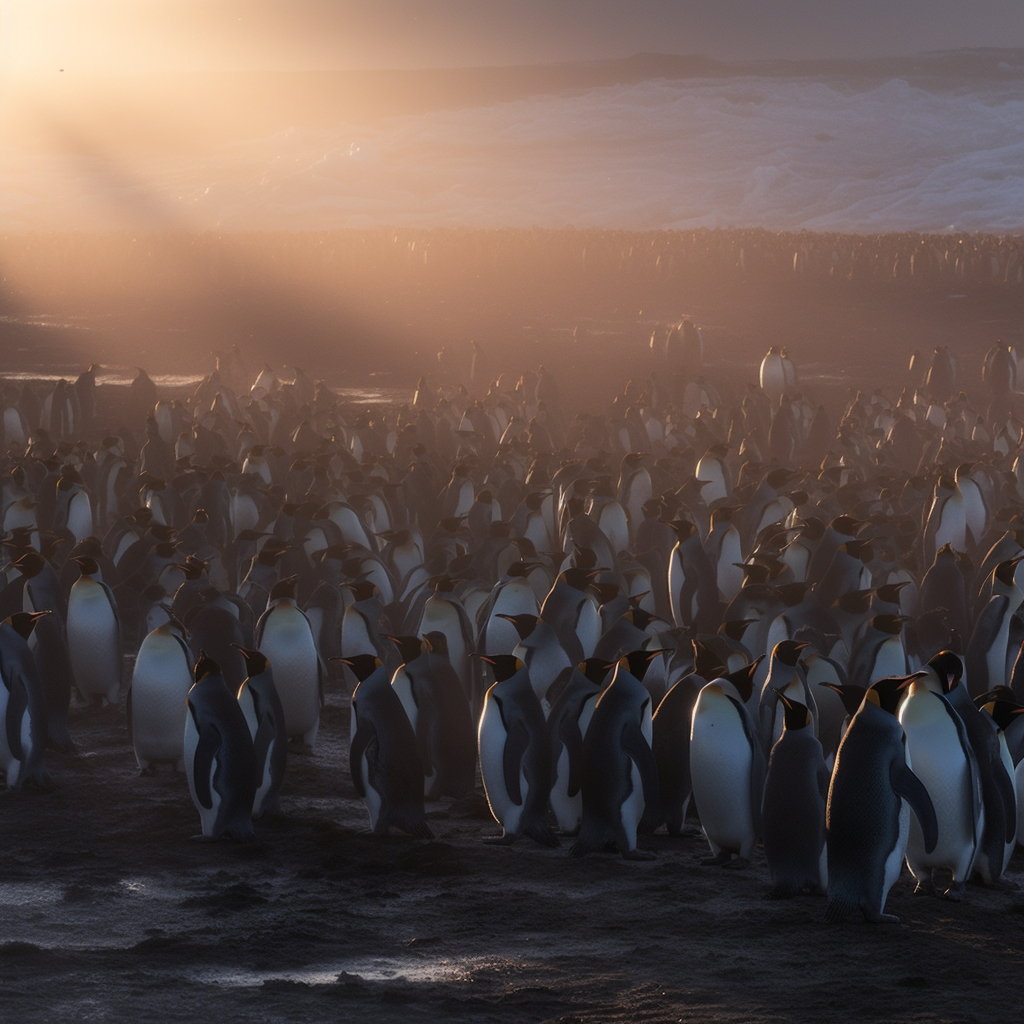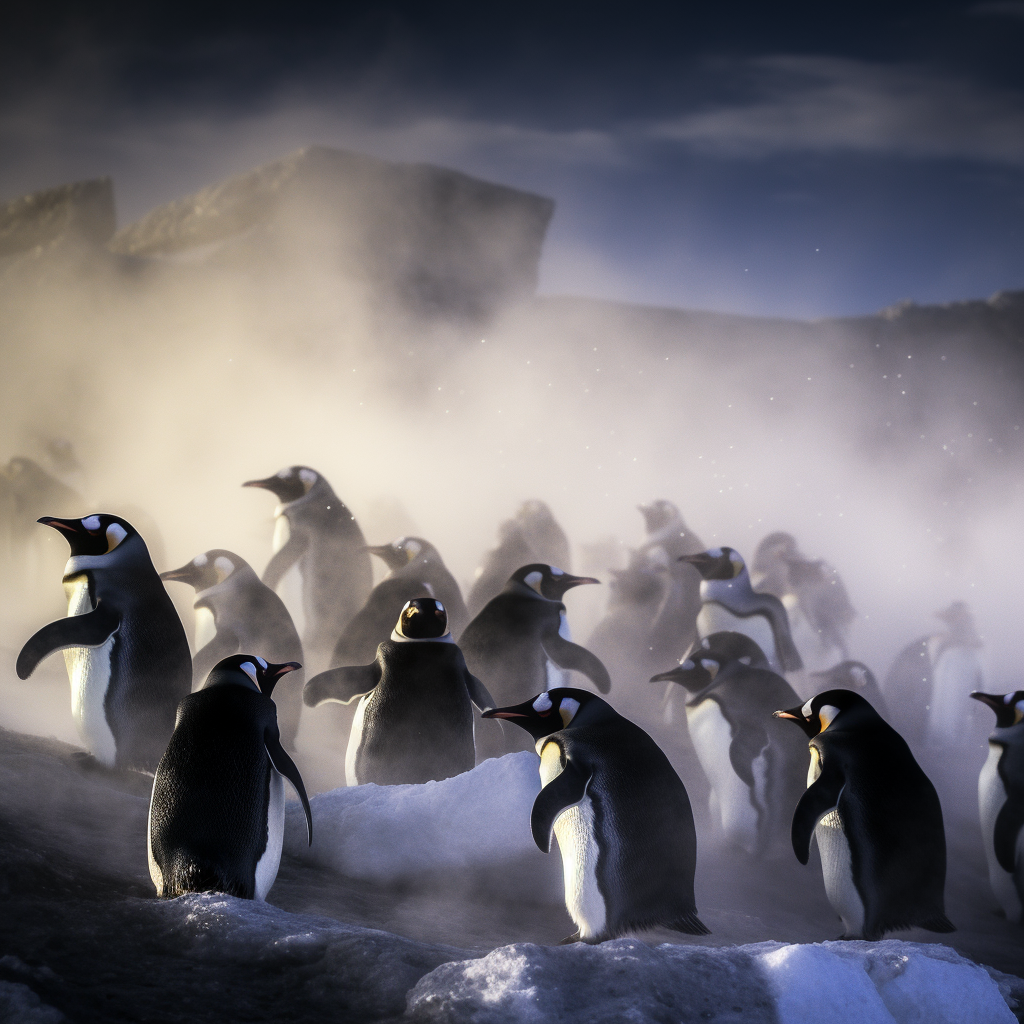Penguins are fascinating creatures that have captured the hearts of many people around the world. Known for their distinctive appearance and adorable waddling walk, these flightless birds are often associated with cuteness rather than aggression. However, have you ever wondered if penguins can fight? In this article, we will explore the intriguing world of penguin behavior and find out if these seemingly docile creatures are capable of engaging in physical altercations. So, let’s dive into the icy waters and discover whether penguins are fighters or peacemakers.
Key Takeaways
- Penguins have evolved to be excellent swimmers and hunters, but they are not built for fighting.
- While penguins may engage in minor disputes over territory or mates, they generally avoid physical confrontations.
- Their survival strategy relies more on cooperation and social behavior rather than aggression.
- Penguins have developed various non-violent displays and vocalizations to communicate and resolve conflicts peacefully.
Understanding Penguins: A Brief Overview
A. Where Can You Find Penguins?
Penguins are fascinating creatures that capture the hearts of many with their adorable waddle and distinctive black and white plumage. While they may be commonly associated with the icy landscapes of Antarctica, penguins can actually be found in various locations around the world. Here are some of the places where you can spot these remarkable birds:
-
Antarctica: As the most iconic penguin habitat, Antarctica is home to several species, including the Emperor Penguin, Adelie Penguin, and Gentoo Penguin. These birds have adapted to survive in extreme cold and harsh conditions.
-
South America: Along the coasts of South America, you can find penguins in countries such as Argentina and Chile. The Magellanic Penguin, Humboldt Penguin, and Rockhopper Penguin are among the species that inhabit these regions.
-
Africa: Surprisingly, penguins can also be found in Africa. The African Penguin, also known as the Jackass Penguin, resides along the southwestern coast of the continent, particularly in South Africa and Namibia.
-
New Zealand: In the southern hemisphere, New Zealand is home to the Yellow-eyed Penguin and the Little Blue Penguin, the world‘s smallest penguin species. These birds can be found on the country’s South Island.
-
Australia: Australia is another country where you can encounter penguins. The most well-known species found here is the Little Penguin, which can be seen along the southern coastlines.
It’s important to note that penguins are native to the Southern Hemisphere, and they primarily inhabit areas with colder climates. However, some species have adapted to live in more temperate regions, showcasing the incredible versatility of these birds.
B. The Lifespan of Penguins: How Long Can They Live?
Penguins have relatively long lifespans compared to many other bird species. On average, they can live anywhere from 15 to 20 years in the wild, although some individuals have been known to reach 30 years or more. The lifespan of a penguin can vary depending on factors such as species, habitat, and environmental conditions.
For instance, Emperor Penguins, the largest of all penguin species, have been observed to live up to 20 years in the wild. On the other hand, the smaller species like the Little Blue Penguin have a shorter average lifespan of around 10 to 15 years.
It’s worth noting that penguins face various threats in their natural habitats, including predation, climate change, and human activities. These factors can impact their lifespan and overall population. Conservation efforts are crucial to ensure the survival of these remarkable birds for future generations to enjoy.
C. The Diverse Habitats of Penguins: Where Can They Live?
Penguins have adapted to thrive in a wide range of habitats, from icy Antarctica to more temperate regions. Each species has its own unique preferences and requirements. Here are some examples of the diverse habitats where penguins can be found:
-
Ice and Snow: Penguins that inhabit Antarctica and the surrounding islands have adapted to survive in extremely cold and icy conditions. They are well-suited to life on the ice, with specialized feathers and a layer of blubber that provide insulation.
-
Coastlines and Beaches: Many penguin species prefer coastal areas, where they can access both land and sea. These habitats provide ample food sources, such as fish and krill, which are essential for their survival.
-
Rocky Islands: Some penguin species, like the Rockhopper Penguin, are known for their ability to navigate rocky shorelines and cliffs. These birds are agile climbers and can be found nesting in colonies on steep slopes.
-
Grasslands and Forests: In more temperate regions, penguins may inhabit areas with grasslands or forests near the coast. The African Penguin, for example, nests in burrows or rocky crevices along sandy beaches.
Penguins have evolved to adapt to their specific habitats, allowing them to thrive in diverse environments. Their ability to survive and thrive in such varied conditions is a testament to their resilience and remarkable adaptability.
In the next section, we will explore the intriguing behavior and social structure of penguins, shedding light on their interactions and potential for conflict.
The Social Dynamics of Penguins

Penguins are fascinating creatures that live in some of the harshest environments on Earth. They have developed unique social dynamics to survive and thrive in their icy habitats. In this section, we will explore the various aspects of penguin behavior and the role that fighting plays in their lives.
A. Do Penguins Fight Each Other?
Penguin aggression is not uncommon, especially during certain times of the year. While penguins are generally known for their adorable waddling and playful behavior, they can also engage in physical confrontations. These confrontations are often a result of territorial disputes or competition for resources.
In penguin colonies, where hundreds or even thousands of penguins gather, conflicts can arise over limited nesting sites, food sources, or even personal space. Penguins have a well-established pecking order, with dominant individuals asserting their authority over subordinates. This hierarchy helps maintain order within the colony and reduces the need for constant fighting.
However, disputes can still occur, particularly during breeding season when competition for mates is fierce. Male penguins may engage in physical battles to establish dominance and secure a breeding partner. These fights can involve flapping wings, pecking, and even body slams. While these skirmishes can be intense, they are usually short-lived and rarely result in serious injuries.
B. The Mating Rituals: Do Penguins Fight Over Mates?
Penguin mating rituals are a sight to behold. These rituals often involve elaborate displays of courtship, with males vying for the attention of females. While fighting over mates is not uncommon, it is not the primary method of competition among penguins.
Instead, males rely on displays of strength, agility, and vocalizations to attract a mate. They may engage in synchronized movements, such as bowing or head-bobbing, to impress females. These displays serve as a way for males to showcase their fitness and suitability as a potential partner.
While physical fights over mates can occur, they are relatively rare compared to other forms of competition. Penguins have evolved various strategies to minimize the need for direct confrontation, such as establishing territories and engaging in vocal duels to assert dominance.
C. What Do Penguins Fight Over?
Penguins primarily fight over resources and territory. In crowded colonies, where space is limited, disputes can arise over nesting sites. Penguins are known to fiercely defend their nests, using their beaks and flippers to ward off intruders.
Food is another precious resource that penguins will fight over. In the harsh Antarctic environment, where food can be scarce, competition for prey can be intense. Penguins may engage in aggressive behavior to secure their share of the available food, especially when feeding their hungry chicks.
D. The Dark Side: Do Penguins Kill Each Other?
While penguins are generally peaceful creatures, there have been instances of more extreme aggression within colonies. In rare cases, penguins have been known to kill each other. These instances are often the result of territorial disputes or conflicts over mates.
However, it’s important to note that such occurrences are relatively rare and not representative of the overall behavior of penguins. The vast majority of penguin interactions are non-violent and focused on maintaining social order and survival.
In conclusion, while penguins do engage in physical confrontations, fighting is not the primary method of interaction within their social structure. Penguins have developed a range of behaviors and communication strategies to minimize the need for direct conflict. Their social dynamics are fascinating and play a crucial role in their survival in the challenging Antarctic environment.
Penguins and Predators: A Survival Guide
A. Can Penguins Fight Back?
Penguins may seem like adorable and harmless creatures, waddling around on the ice, but don’t let their cute appearance fool you. When it comes to defending themselves, penguins are not afraid to fight back. While they may not engage in aggressive battles like lions or bears, they have their own unique ways of protecting themselves and their colonies.
B. How Do Penguins Defend Themselves?
-
Strength in Numbers: One of the primary ways penguins defend themselves is by sticking together in large groups called colonies. These colonies can consist of thousands of penguins, providing safety in numbers. Predators are less likely to attack a large group of penguins, as it increases the risk of injury or failure in their hunt.
-
Speed and Agility: Penguins are excellent swimmers and use their aquatic skills to evade predators. When threatened, they can quickly dive into the water, where they are much faster and more maneuverable than on land. This ability allows them to escape from potential threats, such as seals or sea lions.
-
Beak Defense: Penguins have a sharp beak that they can use as a weapon when necessary. While they primarily use their beaks for catching fish, they can also use them to peck and bite predators if they feel threatened. This defensive behavior is especially common during territorial disputes or when protecting their young.
-
Vocalizations: Penguins have a unique way of communicating with each other, and they can use their vocalizations as a form of defense. When faced with a potential threat, penguins may emit loud calls or honks to intimidate the predator or alert other members of their colony. This vocal communication helps to maintain the cohesion and safety of the group.
C. The Emperor’s Defense: How Do Emperor Penguins Fight Predators?
Emperor penguins, the largest species of penguins, face a different set of challenges when it comes to defending themselves against predators. These majestic birds inhabit the harsh Antarctic environment, where they must protect themselves from threats such as leopard seals and killer whales.
-
Huddle Formation: Emperor penguins have a unique defense mechanism known as huddling. When faced with extreme cold or a predator, they gather together in a tightly packed group, with each penguin taking turns on the outer edge. This formation helps them conserve heat and makes it harder for predators to single out an individual penguin.
-
Camouflage: Emperor penguins have a black and white plumage that helps them blend in with the ice and snow. This natural camouflage makes it difficult for predators to spot them, especially when they are huddled together in a group. By blending into their surroundings, emperor penguins increase their chances of survival.
D. When Penguins Attack: Understanding Their Aggressive Behavior
While penguins are generally peaceful creatures, they can display aggressive behavior in certain situations. These confrontations are usually related to territorial disputes or during the mating season when competition for mates is fierce. Here are some key points to understand penguin aggression:
-
Physical Interactions: When penguins engage in aggressive behavior, it often involves physical interactions such as pecking, flapping wings, or body slamming. These confrontations are a way for penguins to establish dominance and maintain their place in the social hierarchy within the colony.
-
Communication Signals: Penguins use a variety of communication signals to convey their intentions during confrontations. These signals can include vocalizations, body postures, and displays of aggression. By understanding these signals, penguins can avoid escalating conflicts and prevent unnecessary injuries.
In conclusion, while penguins may not engage in fights like other animals, they have developed unique defense mechanisms to protect themselves and their colonies. From strength in numbers and speed in the water to beak defense and vocal communication, penguins have evolved strategies to survive in their challenging environments. Whether it’s the collective power of a colony or the huddling formation of emperor penguins, these remarkable birds have found ways to thrive despite the presence of predators.
Penguins vs Seals: An Unlikely Rivalry
A. Do Penguins Fight Seals?
When we think of penguins, we often imagine them waddling around on the ice, gracefully diving into the frigid waters, and huddling together in their tight-knit colonies. But what happens when these adorable Antarctic birds encounter their much larger neighbors, the seals? Do penguins fight seals?
Contrary to what you might expect, penguins do not typically engage in physical confrontations with seals. Penguins are not equipped with the physical strength or weaponry to take on these formidable marine mammals. Instead, they rely on their agility, speed, and clever tactics to avoid becoming a seal’s next meal.
B. The Tactics: How Do Penguins Fight Off Predators?
-
Group Defense: Penguins are social animals that live in large colonies. This social structure provides them with a collective defense mechanism against predators like seals. When a seal approaches a penguin colony, the birds will gather together, forming a united front. This strategy confuses and intimidates the seal, making it think twice before attempting an attack.
-
Alarm Calls: Penguins have a sophisticated system of communication, including various vocalizations. When a predator is spotted, penguins emit loud alarm calls to alert the rest of the colony. These calls serve as a warning, allowing the penguins to quickly react and take evasive action.
-
Speed and Agility: Penguins are incredibly agile swimmers, capable of reaching impressive speeds underwater. When a seal approaches, penguins will often dive into the water, using their speed and maneuverability to outwit their predator. By swimming in unpredictable patterns and swiftly changing directions, they make it difficult for the seal to catch them.
-
Camouflage: Penguins have evolved to blend in with their surroundings, making it harder for predators to spot them. Their black and white plumage acts as camouflage against the dark ocean depths when viewed from below, while their white bellies blend in with the ice and snow when seen from above. This natural camouflage helps penguins avoid detection and increases their chances of survival.
-
Nesting Strategies: Penguins are diligent parents, and their nesting strategies also play a role in their defense against predators. Many penguin species build their nests in dense colonies, making it harder for seals to single out individual birds. Additionally, penguins often construct their nests in hard-to-reach locations, such as rocky cliffs or dense vegetation, further reducing the risk of predation.
In conclusion, while penguins may not engage in direct physical fights with seals, they employ a range of tactics to protect themselves and their colonies. By utilizing their social structure, communication skills, agility, and natural camouflage, penguins have developed effective strategies to fend off their larger adversaries. These remarkable survival tactics highlight the adaptability and resilience of these fascinating Antarctic birds.
The Emperor’s Courtship: A Battle for Love

A. Can Emperor Penguins Fight?
Emperor penguins, the largest species of penguins, are known for their fascinating courtship rituals. These rituals involve a battle for love, where male penguins compete for the attention of a female. While the term “fight” may conjure up images of aggressive physical confrontations, penguins have their own unique way of competing for a mate.
Unlike some other animals, emperor penguins do not engage in violent fights that result in physical harm. Instead, their battles are more subtle and rely on displays of strength, perseverance, and determination. These battles are more about impressing the female rather than causing harm to other males.
B. How Do Emperor Penguins Fight for a Mate?
Emperor penguins have a complex courtship process that involves several stages. It begins with the males gathering in large groups called colonies, where they establish territories and attract females. Within these colonies, the males engage in various behaviors to assert their dominance and win the attention of a female.
-
Vocalization: Emperor penguins use vocalizations to communicate with each other. During the courtship period, males produce a unique call to attract females. This call serves as a way for males to showcase their fitness and strength.
-
Posturing: Posturing is another important aspect of emperor penguin courtship. Males stand tall, extend their necks, and hold their wings out to appear larger and more impressive. This display of dominance helps them stand out among other males and catch the attention of a potential mate.
-
Ritualized Movements: Emperor penguins engage in ritualized movements, such as head-bobbing and flapping their wings, to further impress the females. These movements demonstrate their agility and physical prowess, indicating their ability to provide for a potential mate and offspring.
-
Endurance: Another way males compete for a mate is through endurance. They endure harsh weather conditions, fasting, and long journeys to breeding grounds to prove their dedication and resilience. This endurance is seen as a desirable trait in a potential partner.
It’s important to note that while these courtship rituals may involve some physical interaction, they are not aggressive fights aimed at causing harm. Instead, they are more like displays of strength and determination to win the favor of a female.
In conclusion, emperor penguins do engage in battles for love, but these battles are not violent or harmful. Instead, they rely on vocalizations, posturing, ritualized movements, and endurance to compete for a mate. These courtship rituals showcase the unique behaviors and social dynamics of these fascinating Antarctic birds.
The Human Perspective: A Hypothetical Scenario

A. How Many Penguins Can a Human Fight?
When it comes to penguins, it’s important to remember that they are wild animals and should be treated with respect. Engaging in physical altercations with penguins is neither recommended nor ethical. Penguins have their own natural behaviors and social structures, and it is crucial to allow them to live undisturbed in their natural habitats.
While it may be tempting to imagine a hypothetical scenario where a human engages in a fight with a penguin, it is essential to prioritize the well-being and conservation of these incredible creatures. Penguins are not aggressive towards humans unless they feel threatened or provoked. It is best to observe penguins from a safe distance and appreciate their beauty and uniqueness.
B. How Do Penguins Fight: A Comparative Analysis
Penguins, like many other animals, have their ways of resolving conflicts and establishing dominance within their colonies. While penguins are not known for engaging in physical fights, they do have various methods of communication and display behaviors that help them establish their place in the social hierarchy.
-
Vocalizations: Penguins communicate through a range of vocalizations, including calls, honks, and brays. These vocalizations serve as a means of communication within the colony, helping penguins recognize each other and establish territories.
-
Body Language: Penguins use body language to convey their intentions and assert dominance. They may display aggressive postures, such as flapping their wings, extending their necks, or bowing their heads. These displays are often enough to resolve conflicts without physical confrontation.
-
Bill Threats: In some cases, penguins may engage in bill threats, where they open their beaks wide and point them towards their opponent. This behavior is a warning sign and serves as a way to establish dominance without resorting to physical violence.
-
Flipper Slapping: When disputes arise, penguins may resort to flipper slapping, where they use their flippers to strike their opponents. This behavior is relatively rare and is usually a last resort when other forms of communication fail.
It is important to note that penguins primarily use these behaviors within their own species and rarely engage in physical interactions with other animals, including humans. Penguins are adapted to their unique environments and have evolved these behaviors to navigate their social structures and maintain harmony within their colonies.
In conclusion, while penguins have their ways of resolving conflicts and establishing dominance, physical fights are not a common occurrence. It is crucial to respect and appreciate penguins in their natural habitats, allowing them to live undisturbed and ensuring their continued survival. Conclusion
In conclusion, while penguins may not engage in physical fights like other animals, they do have their own unique ways of resolving conflicts and establishing dominance within their colonies. Through displays of aggression, vocalizations, and body language, penguins communicate their intentions and assert their positions in the social hierarchy. These interactions are crucial for maintaining order and ensuring the survival of the species. Despite their seemingly docile nature, penguins are far from defenseless and will fiercely protect themselves and their offspring when threatened by predators. Overall, the fascinating world of penguin behavior and communication continues to captivate researchers and wildlife enthusiasts alike, shedding light on the complex dynamics of these remarkable birds.
Frequently Asked Questions
Where can you find penguins?
Penguins can be found in various parts of the Southern Hemisphere, particularly in Antarctica. However, they can also be found in regions like South Africa, South America, New Zealand, and the Galapagos Islands.
Do penguins fight seals?
While penguins can defend themselves, they generally try to avoid direct conflict with predators like seals. Their primary defense is their ability to swim away quickly.
Why do penguins fight?
Penguins often fight due to territorial disputes or during mating season to win the attention of a potential mate. This is a part of their natural behavior and social structure.
How do emperor penguins fight predators?
Emperor penguins primarily use evasion to avoid predators, but they can use their strong beaks and flippers in defense when necessary. They also rely on their social structure and colony for protection.
Do penguins fight over mates?
Yes, during the mating season, male penguins often engage in fights over potential mates. These fights can involve physical interaction like pecking and slapping with their flippers.
What do penguins fight over?
Penguins mainly fight over territory and mates. These fights are a part of their natural behavior and help establish the penguin hierarchy within the colony.
Where can penguins live?
Penguins primarily live in the Southern Hemisphere, with the highest concentration found in Antarctica. However, some species can also be found in warmer climates like South Africa and the Galapagos Islands.
How long can penguins live up to?
The lifespan of a penguin varies by species. For example, Emperor Penguins can live up to 20 years in the wild, while smaller species like the Little Blue Penguins have a lifespan of about 6-7 years.
Can penguins defend themselves?
Yes, penguins can defend themselves. They use their beaks and flippers to fight back against threats. However, their primary defense mechanism is their ability to quickly swim away from danger.
How do penguins fight off predators?
Penguins primarily use evasion to avoid predators. They are excellent swimmers and can quickly dive and change direction in the water. When cornered, they can use their beaks and flippers to defend themselves.




